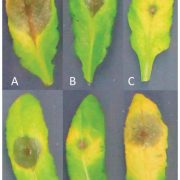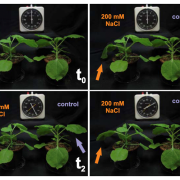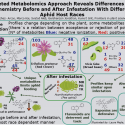Review: MicroRNAs and their regulatory roles in plant–environment interactions (Annu Rev Plant Bio) ($)
 MicroRNAs (miRNAs) are endogenous small noncoding RNAs that negatively regulate the expression of target genes through mRNA cleavage, translational repression and DNA methylation. The last decade has seen an exponential increase in the studies performed to understand the biogenesis of plant miRNAs, their biological and molecular functions, and mechanisms and regulations of their actions. In this context, Song et al. have presented a comprehensive review of plant miRNA biogenesis, mode of actions, and their roles in plant-environment interactions. The biogenesis of miRNA is largely conserved as the miRNA genes undergo transcription to produce primary miRNAs that are processed into miRNA duplexes by DCL (Dicer-like) proteins. These miRNA duplexes are methylated, and the guide strand is incorporated into AGO (Argonaute) proteins to form the miRNA-induced silencing complex (miRISC). miRNAs having near-perfect complementarity with their targets favor target mRNA cleavage; however, several proteins are also reported to interact with miRISC and affect different steps of translation to result in translational repression. Further, a couple of studies provide compelling evidence on miRNA-directed DNA methylation in the nucleus. miRNA-mediated developmental plasticity is a well-studied approach equipped by plants to circumvent the environmental stresses. Abiotic stress-tolerance responses are regulated by the miRNA modules that are evolved in plants, and a few modules are evolutionarily associated with plant environmental adaptation. In case of biotic stress response, miRNAs are capable of directly regulating the defense response or indirectly by acting as a molecular switch to coordinate plant growth and immunity by targeting R genes. (Summary by Muthamilarasan Mehanathan) Annu Rev Plant Biol 10.1146/annurev-arplant-050718-100334
MicroRNAs (miRNAs) are endogenous small noncoding RNAs that negatively regulate the expression of target genes through mRNA cleavage, translational repression and DNA methylation. The last decade has seen an exponential increase in the studies performed to understand the biogenesis of plant miRNAs, their biological and molecular functions, and mechanisms and regulations of their actions. In this context, Song et al. have presented a comprehensive review of plant miRNA biogenesis, mode of actions, and their roles in plant-environment interactions. The biogenesis of miRNA is largely conserved as the miRNA genes undergo transcription to produce primary miRNAs that are processed into miRNA duplexes by DCL (Dicer-like) proteins. These miRNA duplexes are methylated, and the guide strand is incorporated into AGO (Argonaute) proteins to form the miRNA-induced silencing complex (miRISC). miRNAs having near-perfect complementarity with their targets favor target mRNA cleavage; however, several proteins are also reported to interact with miRISC and affect different steps of translation to result in translational repression. Further, a couple of studies provide compelling evidence on miRNA-directed DNA methylation in the nucleus. miRNA-mediated developmental plasticity is a well-studied approach equipped by plants to circumvent the environmental stresses. Abiotic stress-tolerance responses are regulated by the miRNA modules that are evolved in plants, and a few modules are evolutionarily associated with plant environmental adaptation. In case of biotic stress response, miRNAs are capable of directly regulating the defense response or indirectly by acting as a molecular switch to coordinate plant growth and immunity by targeting R genes. (Summary by Muthamilarasan Mehanathan) Annu Rev Plant Biol 10.1146/annurev-arplant-050718-100334









